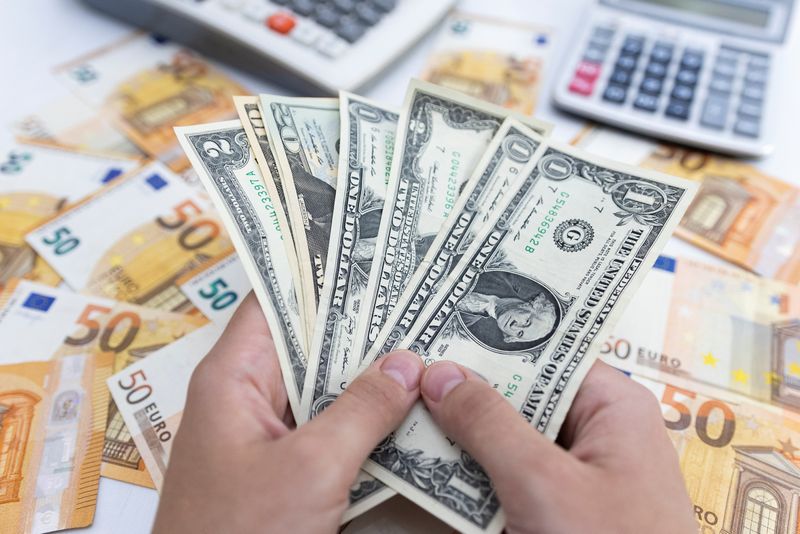 © Reuters. FILE PHOTO: Woman holds U.S. dollar banknotes in front of Euro banknotes in this illustration taken May 30, 2022. REUTERS/Dado Ruvic/Illustration/File Photo
© Reuters. FILE PHOTO: Woman holds U.S. dollar banknotes in front of Euro banknotes in this illustration taken May 30, 2022. REUTERS/Dado Ruvic/Illustration/File Photo
By Gertrude Chavez-Dreyfuss
NEW YORK (Reuters) -The U.S. dollar rose on Thursday after data showed the world's largest economy grew at a faster pace than expected in the fourth quarter, suggesting the Federal Reserve would be in no rush to cut interest rates.
The dollar index, a gauge of the greenback's value versus six major currencies, was last up 0.2% at 103.53. So far this year, the dollar has gained about 2%.
The euro, on the other hand, fell to a new six-week low against the dollar of $1.08215 after mixed comments from European Central Bank President Christine Lagarde. She said it was "premature to discuss rate cuts" for the euro zone economy, but noted that the risks to economic growth remain "tilted to the downside."
The ECB, at its policy meeting on Thursday, left borrowing costs unchanged as expected, re-affirming its commitment to fighting inflation.
The euro last traded at $1.0839, down 0.4%.
In the United States, the Bureau of Economic Analysis' advance GDP estimate showed gross domestic product in the last quarter increased at a 3.3% annualized rate, compared with the consensus forecast of 2% growth rate.
"The dollar overall is stronger today, but given the scope and scale of the GDP beat, I would argue that it should be a lot higher," said Eugene Epstein, head of structuring for North America at moneycorp in New Jersey. "The market, even in the face of all this information that the economy is growing well, still does not buy the higher-for-longer premise that the Fed has given."
Post-data, U.S. rate futures market priced in a roughly 51% chance of easing at the March meeting, up from late Wednesday's 40% probability but down from the 80% chance factored in two weeks ago, according to LSEG's rate probability app.
The market is fully pricing in the first rate cut to occur at the May meeting, with a roughly 94% probability.
The Fed will likely wait until the second quarter before cutting interest rates, according to a majority of economists polled by Reuters. June is seen as the more likely month economists expect the Fed to ease.
"The market is not buying the idea that rate cuts are going to happen no earlier than the summer," Epstein said.
Next week, the Fed is widely expected to stand pat but comments from Chair Jerome Powell will be intensely scrutinized for clues as to when the U.S. central bank will start cutting rates.
For the ECB, money markets priced in an 80% chance of the first rate cut of 25 basis points in April, from 60% before the ECB statement. They also fully factored in 50 bps of cuts by June.
"Today (Thursday), Lagarde had the opportunity to push back on the market pricing and she chose not to, which led to a front-end driven rally," wrote Danske Bank analysts in a research note. "Markets are pricing 140 (basis points) of rate cuts until the end of this year."
A separate report from the Labor Department showed initial claims for state unemployment benefits increased 25,000 to a seasonally adjusted 214,000 for the week ended Jan. 20. Economists had forecast 200,000 claims in the latest week.
Its market impact was muted though given the release of the GDP data.
In other currency pairs, the dollar was up 0.2% versus the yen at 147.705, giving back some of its gains from Wednesday when traders focused on the Bank of Japan's hawkish tilt.
Sterling was down 0.2% at $1.2704.
The Bank of England is due to announce its latest decision on interest rates and its outlook for the economy on Feb. 1. Many investors and analysts have said they expect it will soften its stance against talking about cutting rates from nearly 16-year highs.

